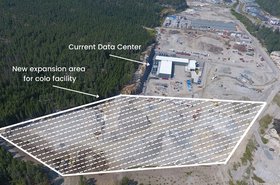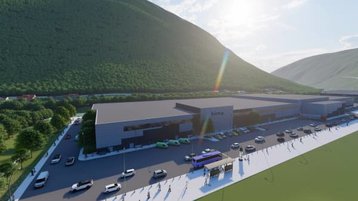In business, any advantage is a competitive one. If your data center can offer the green credentials now so sought after by companies wanting to smash their ESG goals, then their custom you shall have.
The thing is, when it comes to green credentials and sustainability, thinking inside the box, i.e the box that is your own data center, doesn’t do a great deal to help the wider, very much global climate crisis in which we find ourselves.
When DCD spoke to Svein Hagaseth, chief sales officer at Green Mountain, we took a deep dive into all manner of sustainable solutions. From cannibal lobsters to a shift in attitudes, we found out what it really means to think outside the box, creating truly circular, sustainable solutions whose effects ripple far beyond the physical data center.
Green with envy
With three data centers currently based in Norway, Green Mountain arguably has a natural advantage from the get go (quite literally). The abundance of free cooling, temperate climate and cheap energy makes Norway the ideal data center destination.
This is probably why Green Mountain has another two Norwegian data centers currently in development, with both facilities expected to exceed 100 MW. They will of course be powered by 100 percent renewable energy and will be built to meet a sub 1.2 PUE standard.
Operational since 2013, Green Mountain’s first data center, DC-1 Stavanger is a unique tier III certified mountain hall data center (yes, it’s actually in the mountain) that houses both cloud, enterprise and HPC and AI type workloads. DC-1 is located in a former high security NATO ammunition storage facility, with natural free cooling accessible from an adjacent deep water fjord.
Green Mountain’s second facility, DC-2 Telemark, was created in response to popular demand. Clients wanted a disaster recovery (DR) site as well as data center diversity, so Green Mountain delivered the goods, providing a 40MW opportunity at DC-2, a site that had originally been scouted by Facebook for its own Nordic data center. Now we see a huge interest in the site primarily for AI and HPC type of workloads, due to it being located in the power hub of Norway where more than five percent of the power production in Norway is generated, says Svein Atle.
Wanting more, hyperscale clients then challenged Green Mountain to build a third facility in Oslo, and DC-3, a flexible, future-proof data center site in the Norwegian capital was born, which went operational in 2020, and where they recently announced further expansion with a 13.5 MW multi-tenant site due to be operational in Q4 2022.
“Each of our data centers supports Green Mountain’s mission of setting the green standard,” says Hagaseth. “Sustainability is at the core of everything we do and we want to keep pushing that needle on what a sustainable data center actually is.”
And Green Mountain will soon be taking its mission further afield, with plans to cement itself as a truly pan-European player by expanding its presence beyond Norway.
‘Can you deliver a carbon neutral data center, yes or no?’
This was the question put to Green Mountain by German giant Volkswagen, who subsequently chose Norway, and Green Mountain, for its data center. “If the answer was yes, we could answer another 255 questions,” explains Hagaseth, “if the answer was no, we could simply disqualify ourselves.”
But this request was more unusual than you might think, as Hagaseth explains. “Three years ago a German public client would never have evaluated Norway for their data center, but now, these clients are approaching us, saying that sustainability is a more important aspect, and that they will never achieve their carbon neutrality target by 2030 by having a data center in Germany.”
And they’re right. Say you have a 10 MW data center in Norway, compared to having it in Germany, you’d be saving 190 million euro on power alone on a 10-year contract. That’s a 75 percent cost reduction, just from having it in Norway. And Germany’s power sector doesn’t just rely on coal, but also uses lignite, the ‘dirtiest’ form of coal imaginable.
So, it would seem the penny is beginning to drop, but if sustainability is truly important, we also need to be paying closer attention to how ‘clean’ the countries we entrust our data with actually are.
For example in Poland – currently the ‘dirtiest’ country in Europe when it comes to power – the carbon footprint of a kilowatt of power is 650g. In Norway, the equivalent carbon footprint is 24g. So, why would you build a data center in Poland, when you could build a data center in Norway?
“Companies are starting to realize that if they want to meet the 2030 agenda and they’re choosing to build a data center in Poland, for example, there is no way they will get to carbon neutral other than if they buy themselves carbon neutral. You can buy power purchase agreements (PPAs) until you’re ‘green’, but unfortunately this is becoming more of a greenwashing tactic and won’t get truly green energy to your data center.”
Even the latency to key markets is basically the same. For instance, latency from Norwegian data centers to the UK is round trip around 12ms; Amsterdam, 13ms and Frankfurt, 14ms. In fact, 90 percent of workloads in Europe can be comfortably run at around 20ms or below.
For example, before Microsoft announced its Norwegian region, Norwegian cloud clients were running their workloads out of data centers in Dublin, Amsterdam and Frankfurt and nobody complained about latency then. Now, there are more modern and diverse fiber connections and growing data maturity than ever, with workloads put in Norway to serve European demand.
So, with that in mind, why are companies continuing to choose locations like Poland, Frankfurt, or geographies where there is little renewable power, and where there is a power restricting factor in general?
“Keep close whatever you need to keep close, but move whatever you can,” advises Hagaseth. “We need to stop making choices out of convenience. ‘It’s what we did yesterday, so we’ll do it tomorrow’, that’s not going to get us to UN targets. We need to start thinking smarter, and making new choices.”
A new take on an old idea
We’ve heard of heat reuse from data centers before, but not quite the way Green Mountain is doing it.
“We look at heat reuse a little bit differently from the traditional approach in the Nordics. Here, a lot of the discussions have been about the ability to connect to district heating solutions. The problem with district heating is that data centers produce low-grade heat, generally around 25-30 degrees. A district heating solution needs 60-70 degrees of heat.
“Unfortunately, to get district heating to 60-70 degrees, the majority need to add something to it and that something, today is unfortunately predominantly oil or gas, around 50 percent, which takes the effectiveness and green aspect out of those opportunities.”
So Green Mountain posed the question: how can we use the heat directly? How can we use the excess water from our data center in Stavanger, which happens to be around 20-30 degrees?
A survey identified 35 potentially ideal industries that could benefit from Green Mountain’s waste heat and water. Out of the 35 they identified five promising candidates: onshore fish farming, hydroponic farming, protein production, fertilizer production and biogas.
Green Mountain then identified two projects that were consistent with its sustainability mission. The first agreement was signed with a lobster farm that produces plate-sized dinner lobster via an incredibly labor intensive (and surprisingly complex) process.
Lobsters, for the uninitiated, are cannibals, and will eat each other while they are growing. Therefore they have to be bred in small containers that gradually get bigger until they are the size they need to be.
Ideally, lobsters grow at a constant temperature of 20-25 degrees, which is exactly the temperature they’re getting out of the DC-1 Stavanger data center. This growth process ordinarily takes five years, but having a constant temperature coming from the data center, this time is reduced from five years, down to two.
Lobsters, for the uninitiated, are cannibals, and will eat each other while they are growing. Therefore they have to be bred in small containers that gradually get bigger until they are the size they need to be.
Ideally, lobsters grow at a constant temperature of 20-25 degrees, which is exactly the temperature they’re getting out of the DC-1 Stavanger data center. This growth process ordinarily takes five years, but having a constant temperature coming from the data center, this time is reduced from five years, down to two.“Aside from in the future having really good lunches at Green Mountain, it’s a great opportunity for not only optimizing breeding, but to reduce the cost of the facility by 30-40 percent,” says Hagaseth.
The second project, this time at DC-2 Telemark, was signed with Hima Seafood, who are in the process of building the world’s largest onshore trout farm. To do this successfully, similarly to lobsters, trout also require access to a constant temperature all year round.
“There are lots of types of fish farming in Norway, mostly in the sea, but by bringing it onto land you can control the environment better. It also addresses the wider issue of reducing our consumption from red meat, as it hurts the environment quite a lot.
“Moving into other protein sources is one of the key parts of the sustainability story going forward. We need to significantly increase fish production, and onshore farming is a central element to that, the Hima Fishfarm adjacent DC-2 equates to around 1.5 million dinners when at full production.”
Unsurprisingly, the residents of the world’s largest onshore trout farm produce a lot of waste, several tonnes of it annually in fact. Green Mountain plans to take this waste, affectionately known as ‘sludge’, dry it using air from the data centers, and turn it into a highly potent fertilizer that can then be used in greenhouses (that can also get warm water from the data center). How’s that for circularity?
You learn something new every day
Despite the fact Norway is a country primarily founded on wealth brought about by a lucrative oil and gas industry, it may seem somewhat contradictory for it to be flying the green flag so vehemently.
That said, the country has used its fortune to build a truly sustainable environment in Norway, providing incentives for electric vehicles, banning gas and fossil fuels for heating, as well as cutting electricity tax by 97 percent for energy intensive industries like data centers.
Green Mountain has also been looking at the lessons that can be learned from the oil and gas industry. “When you need to do preventative maintenance you don’t want to be sending guys down to the bottom of the seabed every day, so the oil and gas industry is fantastic at implementing a high degree of automation,” says Hagaseth.
“You have to automate, you have to make sure things are maintained and surveyed, and we have taken a lot of that learning into how we operate our data centers.”
Via automation, the components in Green Mountain’s data centers are measured constantly, providing insight that not only means detailed maintenance schedules can be implemented 18 months in advance, but gives clients a transparent view of their environment.
“Through a system we have created called GreenPeak, our clients can go in and check their exact power usage or carbon footprint – which of course other than when we’re running checks on the generators is zero. All of these aspects are built into this GreenPeak solution because we believe that sustainability is also about the ability to have that transparency and share that with our clients.”
You just can’t get the staff
The skills shortage in the data center industry is no secret, but Green Mountain doesn’t seem to have a problem. Why is that?
Well, when you’re based in a country founded on oil and gas, there tends to be an abundance of engineers and technicians milling about, all keen for a career change. “When we are recruiting for people at Green Mountain, we get a lot of the people who are looking to transition out of the oil and gas industry and want to be part of this green shift.
“We’re working with universities, and together with a community college have created a curriculum that is an education programme for data center engineers and technicians. We’re actually taking on several apprentices, which are traditional electricians or other trade skills, and then we’re teaching them the tools of the trade and they go through a certification programme to become qualified,” says Hagaseth.
“Some of our most successful, long-term people at Green Mountain came through our apprenticeship programme. We created something called the Green Academy, which educates the people that we hire, so they have to go through an extensive training programme.”
And we need to be future proofing our industry in terms of people and attitudes, not just tech. We could have the best technology in the world, but if we don’t have the workforce to run it because they’ve all retired, or because they’re unaware of the opportunities in the data center sector, then something has gone horribly wrong.
“If you go to universities today, everyone wants to work with software, nobody wants to work with infrastructure. But that’s because they didn’t know about it. So we’re taking that responsibility, we’re working with several schools, colleges and universities to make sure we do our part.”
Changing the conversation
There are thousands of good initiatives on sustainable data centers, but no one seems to have that holistic view that tells us what actually constitutes a sustainable data center. Unfortunately the majority of sustainability discussions today still center around how much renewable energy is available and the PUE of a facility. But sustainability is so much more than that.
“As an industry, we need to be asking ourselves, how can we create a framework that talks about sustainability from when you’re starting to plan a data center, to when you’re decommissioning a data center, including all different phases of pre and post operation,” says Hagaseth.
This is the conversation Green Mountain is not only having with its clients, but its employees, and the wider industry at large.
“Sustainability isn’t to be a competitive advantage, it needs to be a shared, collaborative effort. This is why I’m so happy to be working with the iMasons, and the Climate Neutral Data Center Pact, and the other things that go on to make sure we’re working on this and talking about sustainability in the same way.”
In summary, if we want a sustainable future for the data center industry, we need to be looking to change behaviors, encourage open conversation, and share ideas. This needs to be a collaboration, not a competition, because the way we’re doing things today, won't get us to where we need to be tomorrow.
More from Green Mountain
-

Green Mountain to expand Oslo campus with 13.5MW data center
Company building multi-tenant facility, due online November 2022
-

Data centers can be part of a circular economy, it is just about thinking creatively
How Green Mountain is setting the green standard by re-using heat waste
-

Sponsored Data centers’ contribution to a true circular economy?
Data center operators need to think bigger and bolder about heat re-use, writes Green Mountain's Svein Atle Hagaseth

